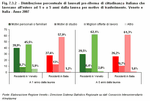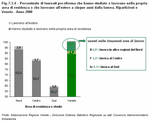7.3 - Regional mobility
|
The European Community favours mobility for purposes of study, work, health or other reasons, so its citizens can fully benefit from the advantages offered by European integration and the single market.
Recently the young have been finding it increasingly difficult to find their first job and when they do pay is often low. We therefore have a human capital which is prepared to move away to find better job prospects and higher salaries.
We often hear about the so-called "brain drain" phenomenon, by which highly qualified people study in one country and move to another for work. As a result, people with great potential move to wealthier, more developed countries that offer better prospects, while the country they leave becomes impoverished as it cannot take full advantage of the human capital being trained there. In Italy, by comparison with other countries, a higher number of young graduates leave than enter, which is not surprising considering that Italy puts less investment into research and development and is therefore less appealing to those intending to work in the sector.
According to the study on the employment situation of graduates conducted by the Consorzio Interuniversitario Almalaurea in 2007 (Note 1), the proportion of Italians who go and work abroad within a year of their graduation is on the rise, although the number did fall last year. The phenomenon is more notable in Veneto where in 2007 2.4% of pre-reform graduates went to work abroad as soon as they had finished university, whilst the national figure was 2.2%. It should, however, be emphasised that the figures for Veneto graduates employed abroad should be read and interpreted with a degree of caution as the relative number of people involved in the study was limited. (Figure 7.3.1) Whether the young people graduated one year or five years earlier, the main reason for moving abroad is for better job offers. The national average and figures for Veneto are more or less the same for some years after graduation, while the figures for a year after graduation differ. In 2007 45.5% of the previous year's Veneto graduates who decided to emigrate did so for a better job (against the national average of almost 58%). Almost 40% of these graduates did so for personal or family reasons (in Italy 27.6%). Fewer Veneto graduates than the national average emigrated to continue their studies. (Figure 7.3.2) Better job offers mean higher economic benefits. The study reveals that those who work abroad earn much higher salaries than those who stay in their country of origin. For example, an Italian graduate working in Italy five years after graduation earns around €1,350, while a graduate living abroad will earn more than €2,100. Veneto graduates working abroad earn even more, at around €2,300. Given the prospects, it is obvious that those working abroad do not intend to return immediately. Most of those working abroad think that they will probably return, but not for at least three years. Over 69% of Veneto graduates working abroad probably intend to return to Italy, that is almost 14% higher than the national average. However, 67% of these do not intend to return within the next two years. Only 14.1% of Veneto graduates and 17.7% of Italian graduates are certain that they will return. (Figure 7.3.3)
According to the most recent information from the graduate employment survey conducted by the Consorzio Interuniversitario Almalaurea in 2008 (Note 2), there is also mobility across the Italian regions. Another result of the study is considerable brain drain from the southern regions which consequently tend to become even more impoverished, losing even those precious resources offered by highly qualified human capital which, if it stayed in the regions of origin, could contribute to the redevelopment of the area. A combined analysis of area of residence, study and work showed diverse geographical mobility among graduates from the North, Centre and South. Students living in the North who graduated in 2003, before the university system was reformed, were interviewed in 2008 (i.e. five years after graduation). More than 93% of them had studied and then worked in their home area. The only significant instances of mobility registered regard the 3% or so who moved abroad. Young people from the Centre were slightly more mobile, although most graduates (almost 83%) never left their home area and only 1.7% went to work abroad. There has been a more notable exodus of graduates from the South. Over 40% move to another area, especially because of problems finding a suitable job in the South, whilst less that 59% have studied and worked in their area of residence and just 1% have tried to seek their fortune abroad. Veneto graduates are the most inclined to move of those in the North in general: five years after graduating, according to the 2008 survey, 89% had studied and currently worked in their home area. This is more than four percentage points below the figure for the North of Italy overall. Furthermore, 2.8% of Veneto graduates who had studied in their home region worked abroad; almost 7% had moved to other regions in the North to work; just 1.2% had moved to the Centre; and very few to the South (0.1%). A higher wage was almost always the main reason for graduates changing cities. (Figure 7.3.4)
The study of the regional mobility of graduates, a precious resource for every country, is fundamental not only for a deeper knowledge of the region, but above all for defining policies of areas affected by intellectual emigration or immigration. In particular, it has become necessary to adopt increasingly appropriate policies which balance incoming mobility with outgoing human capital in various areas to prevent some becoming too impoverished and to avoid favouring those which are already wealthy and advanced, on both a national and international level. |
|
Data processed by the Statistics Office of Regione Veneto are collective property; reproduction of this material is authorised for non-commercial purposes only, provided the source "Regione Veneto - Regional Statistics System Management" is acknowledged.
English translation by the University of Padova Language Centre.







